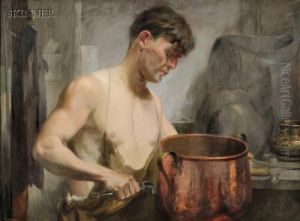George Reiter Brill Paintings
George Reiter Brill was an American painter known for his impressionist landscapes and marine scenes. He was born on March 14, 1867, in Philadelphia, Pennsylvania. Brill showed an early interest in art and pursued his passion by studying at the Pennsylvania Academy of the Fine Arts (PAFA), where he was influenced by Thomas Eakins, a leading figure in American realism. In addition to his studies at PAFA, Brill also traveled to Europe, as was common for artists of his time, to further his education and exposure to the art world. He visited art capitals such as Paris and Munich, where he absorbed the techniques and styles of European impressionists and post-impressionists.
Brill returned to the United States with a wealth of new ideas and techniques that he incorporated into his work. He settled in the New York area and became part of the vibrant art scene there. His work began to attract attention for its vibrant use of color and light, hallmarks of the impressionist style. Brill was particularly skilled at capturing the atmospheric effects of different times of day and varying weather conditions in his landscapes and seascapes. He exhibited his work at various institutions, including the National Academy of Design and the Pennsylvania Academy of the Fine Arts, earning recognition and accolades.
Despite his success, George Reiter Brill's life was marked by tragedy and hardship. He struggled with illness for many years, which often impeded his ability to paint and exhibit. Nonetheless, he continued to work and contribute to the American impressionist movement until his death on December 6, 1918, at the age of 51. Brill's paintings are now held in several collections and are appreciated for their contribution to American impressionism, though he is perhaps not as widely recognized as some of his contemporaries. His work captures a unique vision of America's landscapes and seascapes, reflecting the beauty and diversity of the country at the turn of the 20th century.

